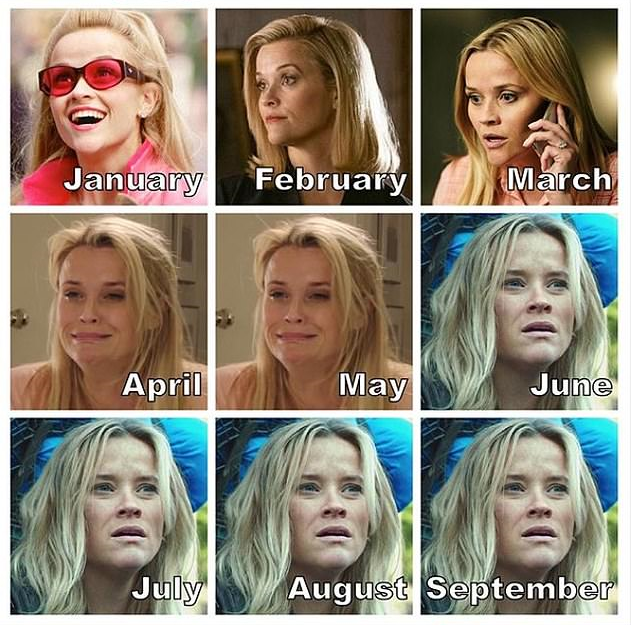So… 2020.
If each year were represented by a cluster of emojis, this one would be: the facepalm, the masked face, the panic/screaming face, the glass of wine, the praying hands for the gratitude-focused among us and finally, that little person doing the shrug. 🤷♀️
You know, the one that says, “NOT PHASED. At all. By any of this. Anymore.”
You might do this shrug when you feel like you’ve reached the ‘acceptance’ stage - but hold on! There’s actually a whole load of “what the hell just happened here?” processing underneath all of this to do.
Here, in Australia, first the country was set alight with the bushfires, then came the floods - and to top it off, COVID - only to kick us while we were down.
Whilst on a global scale, we felt each other’s collective pain - lamenting how the virus has taken its toll on our careers, businesses, physical and mental health and the entire ways in which we live and connect.
Then the memes started to appear.
And oh, how we laughed, through our gritted teeth!
Whether it was Reese Witherspoon parodying herself with stills taken from some of her most-loved films, as she descends into grief and primitivity, as a result of the virus’ impact; or Daenerys in Game of Thrones, with her face that speaks a thousand words at ‘2016’ being the worst year ever.

We used humour as a coping tool, not knowing when our lives would get back to normal, but revelling in the brief joy we could experience in that moment.
And you know what?
It’s been comforting. It’s given us a sense of community; of being in it together.
However, when we take a step back, we realise that what we’re actually doing is creating a narrative that can subconsciously limit us.
The truth is, how we tell the story of this year has the ability to either give or take power away from us, our view of reality and therefore, who we become.
Storytelling has a huge impact.
For example, COVID has undoubtedly been devastating for many - whether it’s losing a loved one, not being able to see your friends and family, dealing with losing your job, having to shut down your business, or feeling isolated and lonely; and these often feel out of your control.
However, the thing that you do have control over is the story you tell yourself about those events - and how they impact your self-concept.
For me, when COVID first hit and Sydney was in full lockdown, as an extrovert who feels most alive when connected to others, I felt so out of balance.
The image I saw was one of being trapped within my own home, not being able to go outside and mix among others, not being able to see my family; not knowing how long this period would last.
Watching the news merely perpetuated this fear.
The uncertainty was almost unbearable at times.
However, as the weeks went on, I realised that my entire narrative was seeing this time as some kind of prison sentence.
And what would happen if I saw it instead as an opportunity to take stock, reflect on my own values and finally work towards understanding what it is that I want to get out of life?
So many of us have lived our lives on auto-pilot, absorbing experiences from moment to moment.
But what I’ve come to realise is that without deeper knowledge about what your core values are, what you care about and the impact you want to have on the world, life often becomes a random series of meaningless actions, leaving your soul unfulfilled.
It’s not necessarily about finding one set-in-stone ‘Life Purpose’, which has to include incredible achievements, such as becoming a successful entrepreneur and turning over a million in your first year (but if that’s what you want, that’s great - and absolutely go for it).
It’s about living a life of your most important values - and feeling energised knowing you’re acting in accordance with these, even in small ways, each day.
It’s not what you do but how and why you do it.
For me, what has helped me tremendously with this is gaining clarity over my own life by creating my own ‘Personal Leadership Statement’.
I put this together when I was coming out of my early adult marriage and faced a number of challenges in getting a divorce.
It was such a daunting and uncertain time - and this experience alone made me realise that being fearless was the best thing I could do for me.
I put together my statement as the sum of the biggest challenges I’ve faced in my life so far and the lessons I’ve learnt, as well as the things that have brought me the most joy and those that resonated with me from childhood onwards.
My mission therefore in my own life is: “To live a fully expressed life and to be fearless in the pursuit of a greater tomorrow, with courage in my heart and compassion in my veins.”
I recommend it to you too! Find something that really speaks to you.
You can create your own as part of our ‘Find Your Why’ course in The Remarkable Woman’s Signature Membership.
And with all of this in mind, here are some other ways you can rewrite your narrative around 2020 and how it impacts your current self and future:
- Write down your current narrative
Take 15-20 minutes to yourself, somewhere quiet and where you won’t be disturbed.
Write down a list of everything significant that has happened this year from your own point of view. This can include events, people that you’ve met or have influenced you, alongside challenges you experienced and perhaps overcame - and emotions around these.
Be as vivid as you can and whatever you do, don’t hold back or judge yourself.
- Discover the theme
What are the most common verbs and themes that come up in your story? Circle these, or make a note on the side.
How do they make you feel? Note down your reflection.
- Rewrite your story
Take another 15-20 minutes to rewrite your story - this time, choosing the theme that you want to use to reframe it.
For example, do you want to see this year as an adventure - perhaps, in discovering yourself?
Really think about the main emotion that you get when writing your new story - and how you want yourself to feel about yourself as you read it.
Of course, you can do this exercise with your self-narrative throughout your life, as well as around 2020.
The key point here is that a lot of us think we can do this in our heads.
Plus - it all seems too easy.
Changing the words around things that have happened - how different will that really make me feel?
But the truth is, there are some things that don’t require years of therapy only, in order to create a shift.
Physically externalising your story by writing it down on paper - and then rewriting it, has the ability to mould what automatically runs through your head on a daily basis.
Often, for the better.
It’s all about changing your habits - and after practising these over time, this incites the cycle of change and enables you to develop fresh neural pathways and ways of thinking - brain training if you will.
This NLP technique is also useful to help you catch yourself when you’re slipping into those old stories in the moment...
- Where are the ‘needs’ and ‘shoulds’?
When we think about our limiting narratives, they are often peppered with “I need to do this” or “I should do this.”
These words are inherently associated with stress, making our bodies tense up at the mere thought of them.
Instead, replace these with affirmative words and phrases. For example, instead of “I need to find the right course with the best ROI so I can upskill”, you can say something to yourself like, “I’m spending some much-needed time on self-care right now, but I will research courses over the next couple of days and find the most appropriate one from the options I can find.”
Know that whatever happens, you will get it done if it matters to you.
And you’re much more likely to without all that unnecessary tension you would’ve stored from thinking repeatedly that you ‘should be’ doing it.
Above all, it’s seductive to stay in our limiting narratives. They give us comfort and they’re familiar.
But when we get back into the driver’s seat and realise we can become the authors of our own lives, that’s when we empower ourselves to create a life of meaning and joy.


